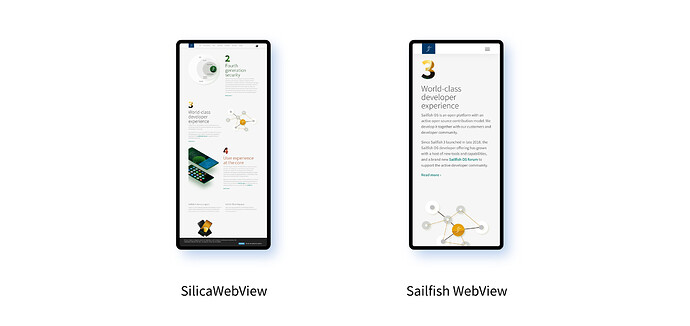As some of you may have noticed from the Sailfish OS 4.4.0 Vanha Rauma release notes, using QtWebKit (or the SilicaWebView wrapper for it) in an app will now trigger a deprecation warning in the logs, like this:
[D] onCompleted:180 - SilicaWebView is deprecated from Sailfish 4.4.0
onwards and will be removed in a future release, use Sailfish WebView
instead. See
https://sailfishos.org/develop/docs/sailfish-components-webview/
We plan to remove SilicaWebView and QtWebKit so that they’re no longer allowed in harbour in an upcoming release.
If you’re an app developer and one of your apps makes use of a SilicaWebView, now would therefore be a really good time to start transitioning your app to use the Sailfish WebView API instead.
The new WebView API harnesses the gecko renderer which is more modern and more compatible. This will improve your users’ experience, but also help avoid potential security vulnerabilities.
And while the SilicaWebView and Sailfish WebView APIs aren’t identical, they provide similar and overlapping functionality. For most developers, converting your app to use the new WebVew should be a relatively straightforward task.
Let’s work through an example. Here’s what a typical page containing a SilicaWebView might look like. Notice that there are a number of experimental options, some of which are pretty much necessary to provide a good result (such as the width and height settings), and some of which may only be needed for specific reasons (such as the user agent setting).
import QtQuick 2.0
import Sailfish.Silica 1.0
import QtWebKit 3.0
import QtWebKit.experimental 1.0
Page {
allowedOrientations: Orientation.All
SilicaWebView {
anchors.fill: parent
url: "http://www.sailfishos.org"
experimental.temporaryCookies: true
experimental.userAgent: "Mozilla/5.0 (Mobile Linux; U; like"
+ " Android 4.4.3; Sailfish OS/2.0) AppleWebkit/535.19 (KHTML,"
+ " like Gecko) Version/4.0 Mobile Safari/535.19"
experimental.autoCorrect: false
experimental.deviceWidth: parent.width
experimental.deviceHeight: parent.height
}
}
Here’s how the equivalent code looks when the SilicaWebView has been replaced with a Sailfish WebView component.
import QtQuick 2.0
import Sailfish.Silica 1.0
import Sailfish.WebView 1.0
import Sailfish.WebEngine 1.0
import Sailfish.WebView.Popups 1.0
Page {
allowedOrientations: Orientation.All
WebView {
anchors.fill: parent
url: "http://www.sailfishos.org"
privateMode: true
httpUserAgent: "Mozilla/5.0 (Mobile; rv:78.0) Gecko/78.0"
+ " Firefox/78.0"
popupProvider: PopupProvider {
// Disable the Save Password dialog
passwordManagerPopup: null
}
}
}
You can also see the full diff between the two in the example’s repository on github.
Some of the differences to note:
- In the updated version we use private mode rather than setting a temporary cookie store.
- The
experimental.userAgentproperty is nowhttpUserAgent, but in practice there should be less need to use this with the updated engine. - In the second case we set a null
passwordManagerPopup. This prevents the app from asking whether it should save the user’s password. This is optional, but probably sensible for many apps.
If you check the diff you’ll notice we also added some new runtime dependences to the spec file.
Requires: qtmozembed-qt5
Requires: sailfish-components-webview-qt5
Requires: sailfish-components-webview-qt5-popups
Requires: sailfish-components-webview-qt5-pickers
As you can see, the process of switching from one to the other isn’t entirely automatic, but is nevertheless pretty painless.
We’d love to hear about your experiences converting your apps, so please share them here in the replies. And if you run into any problems, don’t hesitate to post here and we’ll do our best to help.

